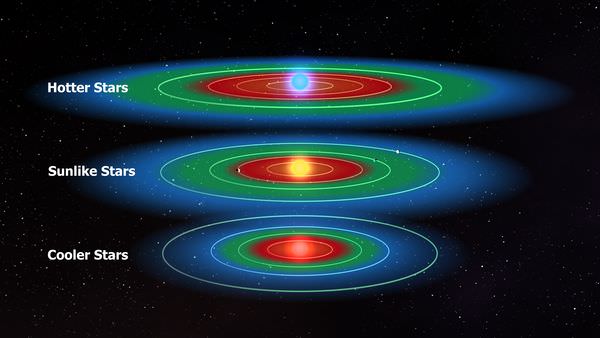Possible habitable zones around stars. Credit: Kepler mission
The Kepler mission announced the discovery of 5 new extrasolar planets today at the American Astronomical Society meeting in Washington, DC, each with some very unusual properties. But additionally, the space telescope has spotted some Jupiter-sized objects orbiting stars, and these objects are hotter than the host star. The science team has no idea what these objects could be, but they are part of 100 planetary candidates Kepler has observed that are still being analyzed.
The Kepler mission's objective is to search for Earth-size planets in the habitable zones of other stars, and the planets announced today are comparable in size to Neptune, Jupiter and the other gas giants of our solar system but are substantially less dense. This first set of five new planets discovered by the Kepler mission was discovered in the first six weeks of the telescope's operation. "The quick discovery indicates that Kepler is performing well," said William Borucki, from NASA's Ames Research Center.
One of these new planets is similar in many ways to Neptune, although its irradiation level is much higher. A second planet is one of the least dense planets ever discovered, and along with the other three, confirms the existence of planets with densities substantially lower than those predicted for gas giant planets. Borucki said Kepler 7b has the density of styrofoam, at .17 grams per cubic centimeter, basically a density of zero.
The smallest planet, Kepler 4b, is 4.31 earth radii, or about Neptune-sized. The other four about the size of Jupiter. All five planets have short orbital periods, and follow-up observations will be made with ground-based telescopes.
Since these planets are close to their host stars, they are very hot, hotter than about 1500 K. 1300 K is the temperature where molten lava flows.
Kepler launched in March 2009 and the mission is expected to last 3½ years. The team now has an additional 8 months of data are now available to analyze. Borucki said in 2010 Kepler will focus on the discovery of smaller planets, with an Earth-sized planet being the "holy grail" of exoplanet discoveries. Other objects detected by Kepler include unusual variable stars, including binaries, oscillating stars, pulsating variables, and more, including other extrasolar planets, but declined to divulge more, saying his team has to be patient and do the confirmations on all the objects before.
Borucki also said data from Kepler will be released to the public on a regular basis starting in June 2010.
Source: AAS Press conference
 Universe Today
Universe Today
